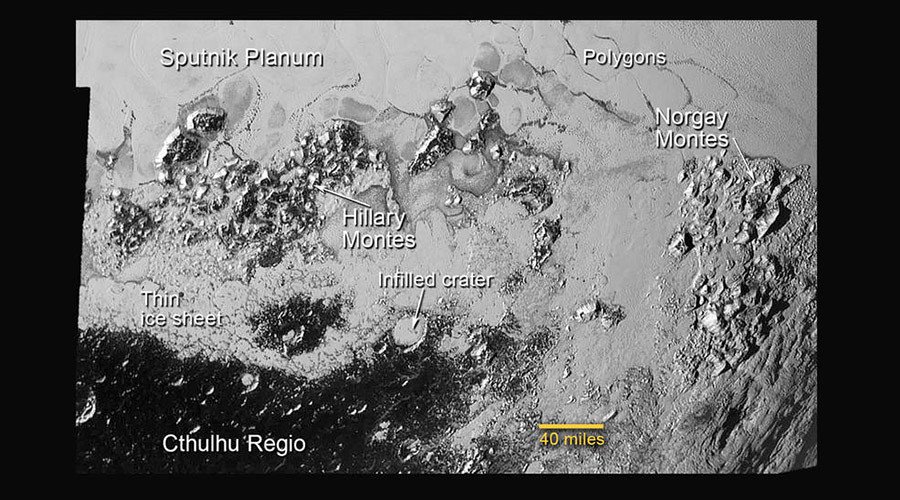‘Big surprise’: Pluto’s hazy atmosphere, flowing nitrogen ice glaciers stun scientists (PHOTOS)

Pluto never ceases to amaze scientists: A new batch of images released by NASA’s New Horizons mission reveal an incredibly hazy atmosphere cast over the dwarf planet, as well as ice flowing on its surface – as glaciers flow on Earth.
The new set of high-resolution images of the planet’s surface reveal ice made of nitrogen, carbon monoxide and methane, flowing on Sputnik Planum, the flat plains on the western hemisphere of Pluto's Tombaugh Regio.
“With flowing ices, exotic surface chemistry, mountain ranges, and vast haze, Pluto is showing a diversity of planetary geology that is truly thrilling,” said John Grunsfeld, NASA associate administrator for the Science Mission Directorate.
According to scientific assessments the swirling patterns of light and dark, seen on new images presented Friday, would look much like glaciers if the observations took place on earth. The key difference is that Earth’s glaciers consist of ice water, but Pluto’s are composed of frozen nitrogen.
“Water ice at Pluto’s temperatures won’t move anywhere. It’s immobile and brittle,” said New Horizons co-investigator Bill McKinnon of Washington University in St. Louis. “The kind of ices that we think make up the planet [Pluto] – nitrogen ice, carbon monoxide ice, methane ice – these ices are soft and malleable even at Pluto conditions, and they will flow in the same ways that glaciers do on Earth.”

Some of the craters on Pluto have even turned into frozen “ponds” of nitrogen ice, as the glaciers emerged, McKinnon added. The analysis of the images taken during New Horizons’ flyby on July 14 made the NASA team speculate that liquid nitrogen could even be flowing below a deep layer of ice.
“If you get down tens of meters, the pressure from the overburden of ice can actually change the properties of the [frozen] nitrogen, so that it’s getting warmer. So it’s much more able to flow. There may even be conditions where you can get liquid nitrogen flowing below a deep layer of ice,” New Horizons project leader Alan Stern said.
According to McKinnon the formation of the plains and ice flows on the surface were probably caused by “heat leaking out of the interior of Pluto”, and there may be an internal ocean that could be emitting heat.

The New Horizons spacecraft was able to depict haze extending at least 100 miles above the surface, as the latest batch of images also includes a backlit view of Pluto. The atmosphere of Pluto backlit by the sun was captured when the New Horizons spacecraft was about 1.25 million miles (2 million kilometers) away.
“The hazes detected in this image are a key element in creating the complex hydrocarbon compounds that give Pluto’s surface its reddish hue,” said Michael Summers, New Horizons co-investigator at George Mason University in Fairfax, Virginia.
“This is our first peek at weather in Pluto’s atmosphere. ... the haze is extensive, it extends at least a hundred miles above the surface. That is a big surprise, that’s five times farther than our models predicted.”

“It really is a mystery,” Summers added, as prior to NASA's expedition, researchers thought the temperature around Pluto would be too warm for hazes to be observed from distance higher than 20 miles (30 km).
“We're going to need some new ideas to figure out what's going on,” said Summers, adding that the new image’s ruining of old existing models “almost brought tears to the eyes of the atmospheric scientists.”
Traveling at a speed of 30,800 mph (almost 50,000kph), New Horizons flew past Pluto at a distance of 7,750 miles (12,472km) – closer than any spacecraft has ever come, on July 14. It took New Horizons 3,463 days and 2.97 billion miles to reach its destination, traveling for an impressive nine years to do so. Now it will take the spacecraft over a year to relay all the images back to Earth.












